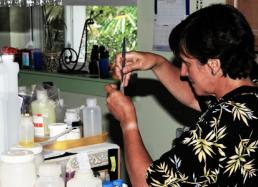The BivAToL Project
Despite their economic and ecological value—as well as their great diversity and abundance in the animal kingdom—bivalve mollusks have been little understood until recently. Dr. Rüdiger Bieler and his colleagues together have spearheaded efforts to coordinate the study of bivalves and reach consensus on their evolutionary history.
The Bivalve Tree of Life Grant
In 2007, the National Science Foundation awarded a multi-institutional grant to Dr. Bieler (The Field Museum of Natural History in Chicago, Illinois); Dr. Gonzalo Giribet (the Museum of Comparative Zoology at Harvard University in Cambridge, Massachusetts); Dr. Paula M. Mikkelsen (the Paleontological Research Institution in Ithaca, New York); and their collaborators, to assemble the Bivalve Tree of Life (BivAToL). The project is part of the Assembling the Tree of Life initiative, a large research effort sponsored by the National Science Foundation with the goal of reconstructing the evolutionary origins of all living things.
Target Species
To trace the bivalve family tree, the team is taking a fresh look at bivalve anatomy and selected molecular markers (genes) for a set of about 280 species of bivalves. Although some of these species will come from museum collections, participants are making special efforts to collect as many species as possible firsthand by shoveling and sieving, dredging, snorkeling, and scuba-diving in several key areas around the world.
Study Goals
Using specimens of the target species, participants will investigate the structure of the bivalves’ stomachs, gills, sperm, and other tissues, their shells, and finally their genes (some of which will be extracted in the field), to produce a bivalve family tree in more detail than has ever before been attempted. While project teams coordinated at The Field Museum and the Museum of Comparative Zoology are concentrating on assembling molecular (genetic) and morphological (anatomical) data, the Paleontological Research Institution participants are concentrating on outreach efforts to engage various audiences in the project’s results and in evolutionary science as a whole.
To stay updated with the team’s progress and keep abreast of ongoing news from the field, be sure to check out the Bivalve Tree of Life website, and don't miss the travelling exhibition, Evolution on the Half Shell, which is based on the team’s research and is currently appearing at The Field Museum.


